For the installation of a power supply system in a new house or during a major overhaul, it is necessary to perform wall chasing for wiring. With the skills and knowledge of the norms for performing the work, even a novice master can cope with the task. The main thing is to strictly follow all the principles and recommendations.
- Basic norms and restrictions
- Features of work on different materials
- Brick walls
- Aerated concrete (foam block)
- Concrete walls
- Preparing and marking the walls
- Basic methods of do-it-yourself slitting
- Chisel and hammer
- Rotary hammer or impact drill
- Bulgarian (grinder)
- Wall chaser
- Individual features of slitting for each case
- How to patch channels
Basic norms and restrictions
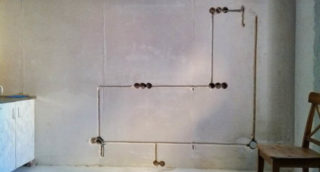
The main requirements for gating are regulated by SNiP.
- All channels must be located strictly horizontally or vertically. It is strictly forbidden to groove under the wiring diagonally.
- The permissible parameters of the channel for the cable are 30 mm width and 25 mm depth. It is allowed to make more strobe only under the air conditioner. Here the maximum depth is 50 mm, width is 60 mm.
- It is forbidden to make multiple turns at right angles between two power points. When laying the wiring in this way in places where it bends, the cable will overheat, which can lead to its possible melting. The norm is one turn.
- The total length of the route to the power point from the junction box should be up to 3 m. Therefore, when developing a scheme for forming strobes for electrical wiring, the shortest path should be chosen.
- The indentation from the door jambs, from the floor and ceiling - 10-15 cm each. It is necessary to remove the channel from the gas pipeline and heating pipes by at least 40 cm.
- When working on load-bearing walls, they must take permission from special organizations. It is forbidden to touch the main partitions of the building, as this may impair their strength. Subsequently, a serious emergency situation arises up to collapse.
- When working on concrete in panel houses, it is strictly forbidden to touch the reinforcement. It provides the required tensile strength of the walls.
- It is forbidden to make grooves in the floor slabs. If you really need to lay the wiring on the floor, it is poured into a concrete screed.
Detailed information on how to gouge walls for wiring and how best not to do this is spelled out in SNiP 3.05.06-85.
Features of work on different materials
The complexity of the slitting (the duration and laboriousness of the process) directly depends on the material in which the channels will be made.
Brick walls
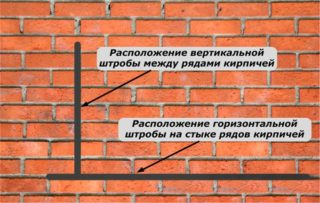
This masonry option may not require complex messy work. If the walls are not yet plastered, you can select a certain thickness of cement mortar between the bricks and lay a flat cable with the required number of cores there. From above, the wiring is covered with a plaster mixture. It is identical in hardness to cement.
If you pass to make vertical sections in brick walls, carefully knock out the desired depth of the channel with a hammer and chisel in the blocks.
Aerated concrete (foam block)
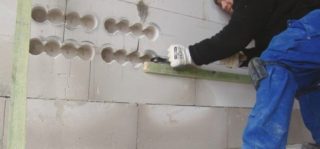
This material is as simple as possible to work with. To make a strobe for wiring in this case, you just need to prepare a hacksaw. The softness of the blocks makes it easy to cut with little effort. But you need to work carefully so as not to damage the aerated concrete. You should not be zealous with the depth of the channels in the foam block walls, otherwise the cable will be laid behind the dew point in the wall. This will not lead to good: water plus current provoke emergency situations.
Concrete walls
It is necessary to work very carefully on the reinforced monolith. It is highly undesirable to touch load-bearing walls. If it is possible to stretch the wiring along the internal partitions, it is advisable to do just that.
Slitting concrete walls, especially in panel houses, is best done with a hammer drill or grinder. The impact tool should be discarded so as not to violate the ultimate strength of the concrete. Even if the reinforcement is clearly visible under the layer of old cement mortar, it is still not touched. The depth of the groove for electrical wiring in concrete is a maximum of 20-25 mm.
Preparing and marking the walls
Before proceeding with the chipping, it is important to identify the old wiring in the walls and eliminate the risk of damage. To do this, you can use indicators or testers. After verification work, you need to apply a preliminary diagram of the branching of the channels under the cable on the wall. Draw lines with a marker from the junction box. It is then easier to move along them with a chasing cutter or a grinder (perforator).
Basic methods of do-it-yourself slitting
There are several effective ways to get the job done. They differ in the type of tool used.
Chisel and hammer
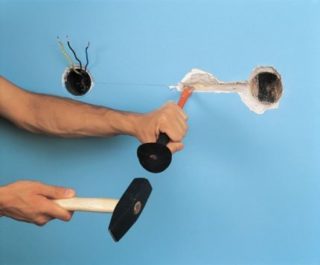
This method is the most old-fashioned. Even with a good skill of the master, it will take a long time to work with a hammer and a chisel. The strobes are curves. Of the minuses - the laboriousness of the process. Of the advantages is the relative cheapness of the method.
They work according to the following principle:
- The chisel tip of the spire (one or two of its depths) forms the course of the channel.
- The tool is placed with a blade across the groove and the excess cement is knocked out - the depth of the grooves is formed.
It is best to work with safety goggles, as pieces of bouncing concrete can injure your eyes.
Rotary hammer or impact drill
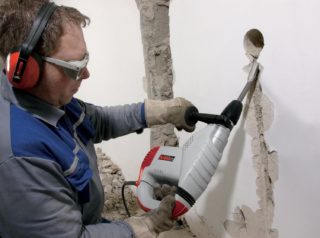
To chisel walls for electrical wiring using a perforator (impact drill), it is worth preparing three nozzles for it - a spatula and two drills of different lengths.
- With a step of 1-1.5 cm, holes 2.5 cm deep are made along the outlined lines.
- Change the nozzle to a spatula and connect all the points in a solid line.
- It remains to knock the channels into the depths using the same scapula.
Of the advantages of working with a perforator, a high speed of the process and relative purity are distinguished. Of the minuses - the formation of channels with curved edges.
Bulgarian (grinder)
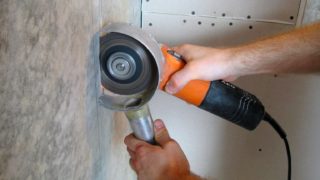
You can grind the walls for wiring with your own hands using a grinder if you have a special diamond disc. With its help, it is possible to make the fastest and evenest cut along the edges of the grooves. Then, using an impact drill and a paddle nozzle, the depth of the groove is selected.
The main advantages of working with a grinder are high speed of the process and minimal damage to the wall. Of the minuses is the intense dusting of the room. Therefore, it is better to work with a respirator. Ideally, there will be an assistant with a construction vacuum cleaner nearby. The suction nozzle of the machine must be kept as close as possible to the working diamond blade. Then dusting can be minimized.
Wall chaser
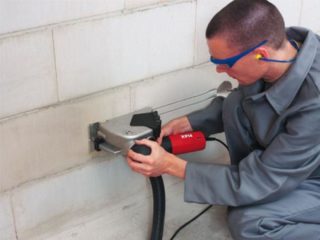
This unit is most suitable for the formation of channels for wiring. Two parallel diamond discs quickly cut grooves of the required width (the distance between the working elements is adjustable). The advantages of a wall chaser are as follows:
- high speed of task execution;
- the presence of a protective casing, which is almost tightly attached to the point of formation of the cut and thus does not allow dust to intensively scatter;
- the ability to adjust the dimensions of the channel (width);
- the presence of a special outlet for connecting a construction vacuum cleaner.
Of the minuses, the wall cutter is presented only with its high cost. There is no point in buying a disposable instrument. As a last resort, you can rent it from specialty stores. They will also tell you which wall chaser to choose for electrical installation.
Individual features of slitting for each case
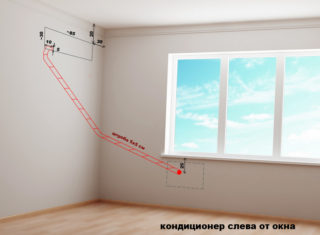
There are several additional features to consider when working with walls:
- Changing under the air conditioner requires the formation of deeper channels. Then you can hide the copper tubes of the unit along with the wires in them. Before starting the chipping, it is advisable to use a metal detector so as not to bump into the reinforcement in the wall.
- Channels are not carved into the wood. This is prohibited by fire safety regulations. On wooden walls, only external wiring for electrics is made using cable ducts. So that they do not stand out much against the background of natural walls, they buy a protective casing for wiring. Cable channels are not sold in running meters, but in pieces of 2-3 m.
- Drywall is also not grooved. Here the cables are laid behind the gypsum board panels. The maximum allowable work on a drywall sheet when laying a cable is the formation of a socket for a socket. It is done using a perforator and a 70 mm crown.
- For chipping a tile floor, it is more correct to use a grinder with diamond discs. The hammer drill will break the tiles.
Self-execution of work saves the master the budget. The price of laying an electrician per running meter is from 200 to 500 rubles.
How to patch channels
The finished grooves are cleaned of construction dust and passed over them with a layer of primer. You can not regret the solution.
After the primer has dried, the cable is laid in the grooves and the channel is moistened before finishing.
The grooves are covered with plaster or blown out with polyurethane foam for pipes. A decorative finish (plaster) is applied on top.








